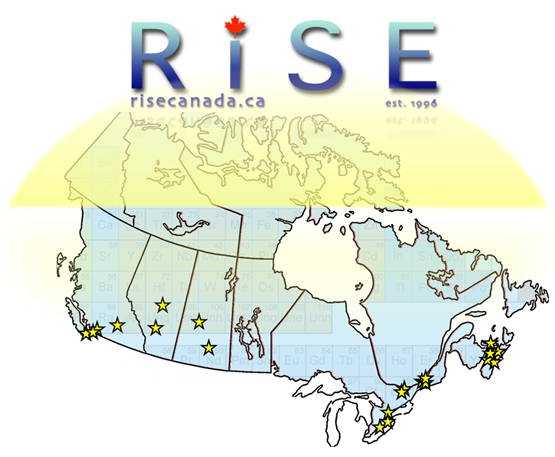The Kennepohl Research Group

Research
Our research centres on exploring the relationship between electronic structure and reactivity in chemical systems; emphasis is placed on using spectroscopy to define electronic structure and probe reactivity. X-ray spectroscopy figures prominently in our arsenal but other methods are also used wherever applicable to assist in determining the electronic and geometric structure of relevant chemical species
Rise Canada Program
RISE Canada (Reactive Intermediates Student Exchange) is a summer student exchange program for undergraduate students in the chemical sciences, who will have completed the equivalent of two or three full years of study as of the end of the school year in which they apply. Successful applicants will be awarded summer employment in the research group of a RISE group member at one of the participating institutions (not their own), and a small travel allowance. Universities with Coop programs normally recognize the RISE summer placement as the equivalent of a Coop work term.
RISE Canada is formed from a group of dedicated RISE Advisors across Canada, whose research emphasizes the study of chemical or biochemical reaction mechanisms. While the research interests of the individuals in the group vary widely, all group members are committed to providing dedicated undergraduate students with opportunities to carry out original research and gain hands-on experience in the use of modern instrumental and other experimental techniques for the study of reaction mechanisms and reaction intermediates.

RISE Canada Members
Prof. Pierre Kennepohl: University of Calgary, Electronic structure and reactivity in catalytic systems - spectroscopy and computational chemistry.
Prof. Kim Baines: University of Western Ontario, Mechanistic chemistry of unsaturated main group compounds, particularly those of silicon and germanium. Development and application of cyclopropyl-based mechanistic probes.
Dr. Michelle Chrétien: Xerox Research Centre of Canada, Fundamental and applied research in materials for xerographic and direct marking technologies; research in organic electronic materials for digital document media, displays, and printed organic electronic consumables.
Prof. Cornelia Bohne: University of Victoria, Supramolecular dynamics, kinetics, photophysics, photochemistry, cyclodextrin, bile salt aggregates, DNA, proteins.
Prof. Neil Branda: Simon Fraser University, Construction of molecular switches to deliberately trigger molecules to undergo structural and functional changes.
Prof. Gonzalo Cosa: McGill University, Novel fluorescence-based imaging strategies: Single Molecule Spectroscopy studies on protein/nucleic acid/lipid membrane interactions, design of fluorescent probes for in vivo imaging of oxidative stress, high throughput biosensors.
Prof. Fran Cozens: Dalhousie University, Organic photochemistry; free radical chemistry; reactions in zeolites and other organized media.
Prof. David Cramb: University of Calgary, Photochemistry, photophysics, photodynamic therapy, nonlinear laser spectroscopies and imaging, excited state dynamics, protein-protein, protein-lipid, lipid-DNA and small molecule - biomolecule interactions.
Prof. Belinda Heyne: University of Calgary, Free radicals and reactive oxygen species in the development of cancer.
Prof. Willie Leigh: McMaster University, Reactive intermediates in organosilicon, organogermanium, and organotin photochemistry, photochemical pericyclic reactions; far-UV photochemistry.
Prof. Glen Loppnow: University of Alberta, Biophysical Chemistry; photochemistry and photophysics of nucleic acids, proteins, and other biomolecules; resonance Raman and optical spectroscopy; DNA and protein microarrays and microfluidics; microspectroscopy.
Prof. Matt Lukeman: Acadia University, Organic photochemistry; photocages; carbanion chemistry.
Prof. Scott Murphy: University of Regina, Supramolecular organic photochemistry; photophysics; photochromism; kinetics; photoresponsive liposomes; drug delivery.
Prof. Xavier Ottenwaelder: Concordia University, Oxidation chemistry with metal complexes; tracking reactive intermediates in oxidation catalysis (nitrenes, oxygen transfer, metallo-radicals); low-temperature spectroscopy and spectro-electrochemistry; kinetic studies.
Prof. Matthew Paige: University of Saskatchewan, Single-molecule and ensemble fluorescence spectroscopy; excited state dynamics; photophysics of fluorescent nanoparticles; spectroscopic properties of aggregated molecules.
Prof. Christian Reber: Université de Montréal, Spectroscopy and photochemistry of inorganic and organometallic compounds; luminescence, absorption and Raman spectroscopy at variable temperatures and pressures; modeling of excited-state processes.
Prof. J.C. (Tito) Scaiano: University of Ottawa, Kinetic and mechanistic studies of organic reaction intermediates; organic photochemistry; two photon processes; photoreactions in organized media; laser techniques; chiral recognition; magnetic field effects; photoresists.
Prof. Greg Scholes: Princeton University, Nanocrystalline semiconductors; ultrafast laser spectroscopy; theory of energy transfer; photophysics of pi-conjugated systems; solar energy conversion.
Prof. Will Skene: Université de Montréal, Light shuttling materials; dynamic polymers; snap-on conjugated polymers; luminescent materials.
Prof. Brian Wagner: University of Prince Edward Island, Fluorescence spectroscopy of supramolecular host-guest systems.
